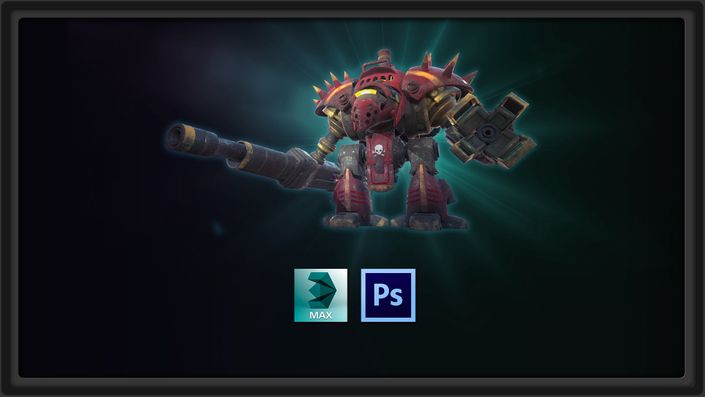
Model and Texture a Dreadnaught Character From Start to Finish
Complete Start-to-Finish Production of a Weaponized Dreadnought Mech for Games or Film!
Watch Promo
After creating a mesh, in this case a mechanical Dreadnought, it's not enough to simply have a greyscale model...now comes texturing! Texturing models can be a daunting task because there are so many tools/programs geared towards creating texturing that are stylized or physically based, it can be confusing. Photoshop, a standard in texturing, is the simplest, most direct method to create first a color base and then add details, via masks, to the colors for better realism. Once the model has a base diffuse/albedo, we can then still use Photoshop to create the glossiness and metal maps to support PBR workflows without requiring any third party (or more expensive) program to create acceptable end results. One need only understand the PBR basics to understand how using simple Photoshop filters and masks can help create the needed details to make our model look dirty/rusty and worn as nothing looks faker or more phoney than perfect colors on a Dreadnought mechanical robot that has seen many battles.
Finally, we'll be able to first create a base diffuse/albedo so we have the color scheme for the mech and then we'll focus on creating the detailing/dirt/grime needed to help give the diffuse/albedo a more 'lived in' quality. Masking is an integral part of Photoshop's suite of tools and we'll be using it to help with our colors as well as our metals.After we established our color palette, it'll then be deciding which parts of the mech are metallic, which are rubber and which are plastic so we can use Photoshop to help create the different textures needed for the PBR pipeline.
Your Instructor

Having 25 years of experience in the video game development and digital entertainment arenas, Stephen is well versed in a variety of programs and production pipelines and strives to work as cleanly and efficiently as possible. Having done pretty much everything imaginable in the 3d industry, he enjoys getting to share his knowledge and experience in the hopes to help students gain a better understanding and appreciation of what 3D computer art (in all its varying forms) has to offer.
Course Curriculum
-
Preview1363-01-Intro (1:12)
-
Start1363-02-The Upper Body and Arm Socket (13:03)
-
Start1363-03-Instancing the Upper Arm (14:39)
-
Start1363-04-Boolean the Forward Exhaust Ports (18:41)
-
Start1363-06-Shelling and Adding Screws and Spikes (13:29)
-
Start1363-05-Using Splines to Create the Shoulders (16:11)
-
Preview1364-01-Intro (1:09)
-
Start1364-02-Creating the Hip Joint (15:08)
-
Start1364-03-Creating Legs Bones and Booleans (14:15)
-
Preview1364-04-Fixing the Upper Leg (14:53)
-
Start1364-05-Finishing the Shin (14:44)
-
Start1364-06-Toes with Splines (16:12)
-
Start1364-07-Finishing Toes and the Foot (15:19)
